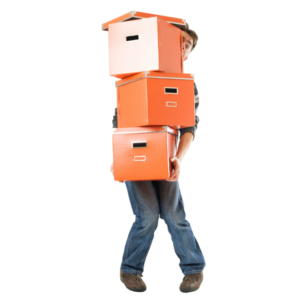£0.00
0Top 5 rules for safe Manual Handling
Manual handling refers to any task that involves a person lifting, lowering, pushing, pulling or carrying loads. These actions can occur in the majority of workplaces and in a wide range of environments, with loads varying in shape, size and weight.
To avoid injury and damage (to people as well as goods) it is vital to follow proper techniques when manually lifting, supporting or moving any load.
We have listed below, what we consider to be the Top 5 Rules that should be followed for safe manual handling in all situations. However, depending on the environment and the type of load being moved, there may also be further specific rules and techniques that should be followed.
1. Always assess the situation before attempting any manual handling
Think before you act. It’s an obvious one but it doesn’t always happen. So here are some key questions to consider before undertaking any manual handling task:
- How heavy is the load?
Before undertaking any manual handling, understand the weight and size of the load. If it is really heavy, or is an awkward shape, think whether it can be broken into lighter or smaller parts. If breaking it down is not possible, make sure that you use appropriate handling equipment that is designed to make the task safer and easier to manage. Such equipment might be trolleys, skates, trucks or other lifting equipment. There is a large choice of manual handling equipment specifically designed for all manual handling tasks – please make use of it. - How far is the load being moved?
Make sure that you consider the distance that the load needs to move. If it is a long distance, make sure that there is the opportunity to adjust the grip and rest the load part way. Where possible, reduce carrying distances for example, this could be achieved by the reorganisation of storage areas to minimise how far heavier items need to be moved. - Where is the load being moved to?
Check that there are no potential hazards such as steps or stairs along the way and that you are aware of any trip hazards or unevenness on the floor.
- What height is the load being moved to / from?
For safety reasons, to avoid injury, it is important to avoid lifting heavy loads from floor level or from above shoulder height. This is typically where most injuries happen. If such movement is necessary, you should use mechanical aids to help. - Will help be needed?
Decide if more than one person is needed for the task or if manual handling equipment is needed. If special equipment is needed, then please use it! Also don’t try to use inappropriate equipment just because it is available. Trying to improvise with inappropriate equipment is likely to cause unforeseen accidents. Use the right equipment for the job. - Is the load stable?
Remove any loose packaging that might affect your grip or cause the load to shift. Check whether the weight of the object is balanced and take this into account.
2. Use correct lifting and moving techniques
When lifting, make use that you bend your knees and hips, not your back. Keep your back straight and don’t tense your shoulders. Stand with feet apart and one leg slightly forward to help your balance and give you a stable base.
When moving the load, avoid twisting and turning – your shoulders and hips should always face in the same direction. Ensure that you minimise the amount of twisting and reaching involved if you can’t avoid it altogether. Turn using your feet to pivot if, rather than twisting your body.
Keep the load close to your body as much as possible, so that your arms are not over extended. Ensure that the load is stable by keeping the heaviest side close to your body.
Look where you are going! Once the load is lifted, make sure that you look ahead and not at the load. Be aware of other people who may be moving about to avoid collisions.
3. Get a grip!
Get a good grip. Make sure that you have a secure, firm grip on the load before lifting it or moving it so that it does not slip. Use any handles that are available and are designed to assist with the lift and shift process.
Use gloves if necessary to improve your ability to grip the load and to maintain your hold on it.
Holding the load close to your body, in a hugging position, may improve your grip and help you to get a better hold of the object. Holding a load away from your body will make it seem much heavier.

4. Don’t overdo it!
Manual handling is a strenuous activity, so it is important to have regular breaks to stretch and rest. Muscles can become fatigued and need a chance to recover. Always be aware of how you are feeling and stop or ask for help, if you are tired. It’s often hard to ask for a break if you are part of a team and others are carrying on. But if your body is saying take a break listen to it. The consequences of soldiering on could be bad for you and your work colleagues.
Don’t lift or carry a load that is too heavy for you or that causes you to strain when moving it. You may see others carrying the same load but ego and bravado are not your friends in situations like this. Do remember, there is an important difference between what you can lift – and what you can lift safely!

5. Setting the load down
The pick up and put down moments are often the ones where injury can occur. Ensure that the object is set down safely, avoiding potential injury to yourself by bending your knees and hips, not your back. It is the same guidance for lifting the load.
Once the object is down, it is often easier and safer to slide it into its final position rather than attempt to lift it again.
Make sure that the object has been set down in a safe place and not in a position where it will cause a hazard to others or where it will need to be unnecessarily moved again because it is in the way.
Following these guidelines will help you to reduce the risk of injury and to lift, move and place loads safely. Always consider your individual capacity, the nature of the load and your environment as these will differ from one situation to another. Moving a load outside on a dry may be very different to doing the same thing on a wet day, or a windy day.
Always follow the specific safety guidelines set out by your workplace or organisation.
Those guidelines are not there to make your task more difficult. They are there to protect you from injury and the load from damage.
Ask BIL for Help and Guidance
If your organisation needs to move heavy, awkward, loads or lots of lighter loads very often – and you are doing it without any manual handling equipment, then please ask us for advice on what is available to help you. We are manual handling experts and most likely we will be able to recommend specific equipment that will;
- Keep everyone safer in the workplace
- Make your business more efficient in your ‘lift and shift’ tasks
- Save you time and money over the longer term.
BIL are here to help make your work life easier! Please contact us. We would be delighted to hear from you.
